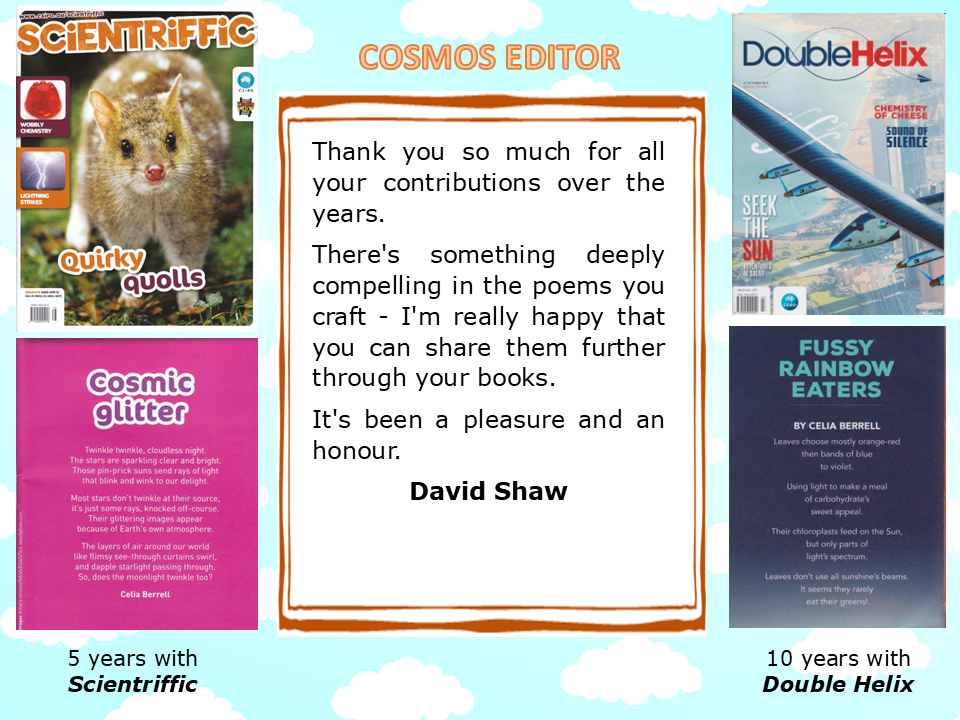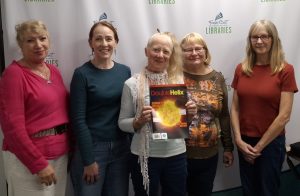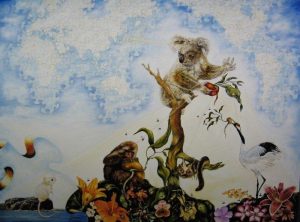The Beauty of it All by Celia Berrell
All we can touch, and all we see
began in cosmic history.
How long ago came things to be?
Perhaps it was infinity.
All our surroundings hold in store
the clues to what has gone before.
A fascination long prevails
to understand time’s every tale.
Our tiny Earth holds precious gifts
as through the universe it drifts
with organisms varied, rife,
are we alone in having life?
This special form of energy
enduring in its frailty
bestows such beauty, all admired.
Intelligence is awe inspired.
THE BEAUTY OF IT ALL is one of ten poems from the Environmental Poetry page of the Science Rhymes website (2009). Guided by James Cook University A/Prof Hilary Whitehouse’s environmental education topics, and Sharon Davson’s spiritual art, THE BEAUTY OF IT ALL was inspired by Davson’s painting Called Away. The poem and image were published together in Australia’s Macmillan English 7, edited by Sandra Bernhardt (2011), and the poem is now scheduled for publication with Amity University Press, based in Noida, India (2025).

Called Away by Sharon Davson
Called Away is an oil painting of an open book with the makings of a jig-saw puzzle draped over it. The upper section of the puzzle is about TIME and the lower section is about LIFE. The first two verses of The Beauty of it All are the poet’s responses and questions about TIME. The second two verses about LIFE.
“Without stardust and starlight, our universe may not have existed. We now know all the atoms, gas, dust, rocks and substances we can touch and see probably appeared as a result of a ‘Big Bang’, believed to have happened 14 billion years ago.”
All we can touch, and all we see began in cosmic history.
“Before scientists and astronomers came up with 14 billion years as an age for our universe, some people thought it was around six thousand years old, while others believed it had no beginning or end. Maybe the ‘Big Bang’ was just one of many ‘Big Bounces’; or perhaps we live in a Multiverse! Despite our universe’s age-estimate being 14 billion years, we can still choose to think that some version of our universe may have existed forever – for infinity.”
How long ago came things to be? Perhaps it was infinity.
“Since fossil hunters and geologists began finding bones of extinct animals such as the dinosaurs, and other fascinating facts about the cosmos going back in time, scientists have continued to collect plenty of clues and evidence. We’ve discovered many things about significant environmental and historical events here on Earth and beyond.”
All our surroundings hold in store the clues to what has gone before.
“Our insatiable human curiosity means that many of us want to find out even more! More about what has happened in the past (through studying things like rocks and stars), and what future conditions may be (through including computer models and Artificial Intelligence to crunch all our discovered information).”
A fascination long prevails to understand time’s every tale.
“Since Astronauts ventured into space, especially with travelling to the Moon in the late 1960’s, we have had the precious privilege of seeing what planet Earth looks like from afar. In the scheme of the Solar System and the cosmos, IT’S VERY SMALL! And as far as we know, it may be the only place where living things exist. But that question bugs us no end … do we really want to know the answer? It could be scary – either way!
Our tiny Earth holds precious gifts as through the universe it drifts
with organisms, varied, rife. Are we alone in having life?
“Through our knowledge of fossils, ice, rocks and extinctions, we have begun to realise that our planet’s environment can change – sometimes dramatically. We now understand that life on Earth was almost completely wiped out a number of times. Life is really rather fragile!”
This special form of energy, enduring in its frailty,
“But we only have to look around us, in nature and out to the stars, to see that we are supported and surrounded by stuff that is truly fantastical; sometimes inexplicably crazy; inspiring; puzzling, yet frightfully gorgeous.
Bestows such beauty, all admired
“But does that garden snail see the same wonder as a human being does? No. Our awareness, sentience and magical minds give us the ability to REALISE HOW AWESOME nature really is! Your pet dog might howl at the moon sometimes and delight in sniffing the weirdest smells, but even such closest creature relatives can’t see the world quite like us. We have our intelligence to thank for that. And either, with or without science in your hearts, THE WORLD IS AMAZINGLY AMAZING!!! So, please try not to take it for granted.”
intelligence is awe-inspired.











